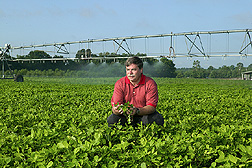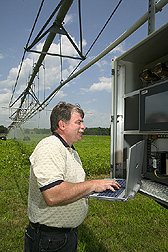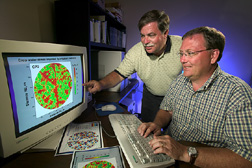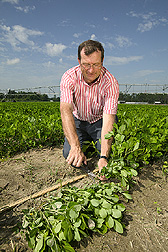Fields With a Mind of Their Own?
Precision systems can fine-tune irrigation
Gazing out over his corn crop, a farmer is watching an irrigation system deliver bursts of water across the gently rolling field. Some of the sprinkler heads spray more water onto the field than others. Some aren’t spraying water at all.
The system isn’t broken. The farmer is using precision irrigation to bring water to the portions of his field that are the thirstiest. While he wants to make sure that each corn plant gets enough water, he needs to make sure it’s not too much. That might lead to groundwater contamination and runoff—and higher costs.
Working to bring this sort of precision to the nation’s irrigators, several ARS laboratories across the country are merging traditional irrigation equipment with the latest in hi-tech gadgetry—from infrared sensors and global positioning systems (GPS) to wireless communications. These locations include the Coastal Plains Soil, Water, and Plant Research Center in Florence, South Carolina; the Water Management Research Unit in Fort Collins, Colorado; and the Northern Plains Agricultural Research Laboratory in Sidney, Montana.
|
|
Not All Fields Are Alike
Many growers have always treated their fields as an average of features, while in reality there can be tremendous differences in soil type, topography, and water needs. For instance, agricultural engineer Kenneth Stone says that in Florence, there can be 10 to 12 different soils in a single 14-acre field.
More precise delivery of water, nutrients, and pesticides could also benefit the environment. According to Robert Evans, an agricultural engineer at the Sidney lab, “Overwatering can cause chemicals to leach into groundwater.” And plant leaves, which may stay wet when too much water is applied, are more vulnerable to diseases caused by fungi. Better management can reduce the number of fungicide sprayings, he says.
For more than 10 years, scientists in Florence have been investigating precision irrigation as a way to sidestep some of these problems and potentially save busy growers resources and time. Stone, who’s been in charge of this irrigation research for about a year, defines precision irrigation as “trying to match water application with variations in the soils and crops within a field.”
The team is currently looking at irrigation levels on wheat and soybeans but has spent many years studying corn. The experiment began with soil scientist E. John Sadler, now research leader for ARS’s Cropping Systems and Water Quality Research Unit, Columbia, Missouri, and now-retired agricultural engineer Carl R. Camp. The two men worked with five other researchers to determine what capabilities were needed for site-specific irrigation. Up to that point, if a farmer wanted to give an area of a farm more or less water, the farmer had to manually change the sprinkler levels based on limited research. This method was neither cost effective nor productive.
The team bought their first two commercially available, center-pivot irrigation systems in 1993 and, over the next several years, tested and modified them.
They’ve since done many studies on how to take a wide range of variables—like soil quality, crop type, and temperature—from a small section of a field and assess them together to determine when and where water should be placed. The next step is to get the irrigation systems to activate automatically in response to real-time field data.
ARS is conducting this research at its other locations as well because South Carolina’s climate—with its hot, humid summer—is different from that of much of the country. Also, its soil is more heterogeneous than at other locations, thus affecting crops differently.
|
|
Across the Plains
At Sidney, Evans is evaluating the potential for precision irrigation in the Montana-Dakota region. Rainfall there, at best, reaches 14 inches a year, and irrigation is a way of life. Evans is finding out what kinds of modifications will allow traditional, self-propelled irrigation equipment—such as center-pivot and linear-move systems—to more precisely deliver water and nutrients across a widely varying landscape.
“There’s a lot of potential for irrigation expansion in the region,” says Evans, “with an emphasis on cultivating value-added crops like herbs, seed crops, and plants for biofuels.”
Many irrigators are shifting from surface systems to center pivots, which provide an ideal platform for mounting precision-oriented hardware—such as sensors for monitoring plant and soil conditions in real time.
Evans is building on research he did at Washington State University in Prosser, in collaboration with ARS’s Vegetable and Forage Crop Research Unit, also in Prosser.
“Because of their soil type and topography,” he says, “fields we studied in the Pacific Northwest were susceptible to leaching nitrate-nitrogen and other agrichemicals.” Some parts of these slightly rolling irrigated fields were being overwatered by as much as 20 percent. Using simple modifications to commercially available irrigation equipment, Evans experimented with different pulsing technologies that could deliver the right amount of water, in the right place, across a field.
|
|
“We also had a computer in the farm office communicating with the pivot controllers,” says Evans, “as well as an on-site weather station providing hourly updates via radio modems.”
“The technology works,” says Evans. But he believes there’s much more potential for saving growers water and agrichemical costs. At his Sidney lab, he’s incorporating GPS, wireless communications, and infrared technology for real-time monitoring of plant and soil needs. At a study site near Sidney, he’s distributed tiny meteorological sensors across a field. These provide continuous feedback to the main control system, which is capable of helping growers make on-the-go decisions about irrigation.
Further south, research leader Dale F. Heermann is leading a group of scientists in Fort Collins in testing precision-irrigation research. The group is looking at how irrigation systems fit in with other inputs, such as chemical applications. Heermann’s group was one of the first to publish results about the benefits of precision irrigation, starting in 1992. Their work laid the framework for other ARS and university scientists.
The team developed a computer program, Center Pivot Evaluation and Design, which models water distribution. The farmer or researcher enters information about the field—as well as how the irrigation system is set up—to learn how efficient the irrigation will be. The model is also included in the sprinkler irrigation standards of ARS’s fellow agency, the National Resources Conservation Service. It is used to evaluate the design of center-pivot systems for cost sharing under the Environmental Quality Incentive Program.
The group also spent several years testing the Accu-Pulse system, patented by Valmont Industries, Inc., headquartered in Omaha, Nebraska. Accu-Pulse attaches to commercial center-pivot systems and allows farmers to apply chemicals at variable rates. The chemicals are not injected into the irrigation water, thus preventing possible contamination of the water supply.
“In our studies, the Accu-Pulse system has proven to be very successful,” says Heermann.
Heermann’s unit has also developed technology for sensing soil and plant status to apply the minimum amount of nitrogen and herbicides for crop production and weed control. With Accu-Pulse, the scientists were able to use fewer applications of water and chemicals while getting the same, if not higher, yield.
“We’ve found that the Accu-Pulse system can reduce the amount of fungicide needed for potato production,” Heermann says, “potentially saving $60-100 per acre.” And the amount of nitrogen in the soil which can be leached was reduced by 110 pounds per acre.—By David Elstein, formerly with ARS, and Erin K. Peabody, Agricultural Research Service Information Staff.
This research is part of Water Quality & Management (#201) and Soil Resource Management (#202), two ARS National Programs described on the World Wide Web at www.nps.ars.usda.gov.
Kenneth C. Stone is with the USDA-ARS Coastal Plains Soil, Water and Plant Research Center, 2611 W. Lucas St., Florence, SC 29501-1242; phone (843) 669-5203, ext. 111, fax (843) 669-6970.
Robert G. Evans is with the USDA-ARS Northern Plains Agricultural Research Laboratory, 1500 N. Central Ave., Sidney, MT 59270-4202; phone (406) 433-9496, fax (406) 433-5038.
E. John Sadler is in the USDA-ARS Cropping Systems and Water Quality Research Unit, 269 Agricultural Engineering Bldg., Columbia, MO 65211; phone (573) 884-1971, fax (573) 882-1115.
Dale F. Heermann is in the USDA-ARS Water Management Research Unit, 2150 Centre Ave., Bldg. D, Suite 320, Fort Collins, CO 80526-8119; phone (970) 492-7410, fax (970) 492-7408.
"Fields With a Mind of Their Own?" was published in the October 2005 issue of Agricultural Research magazine.










